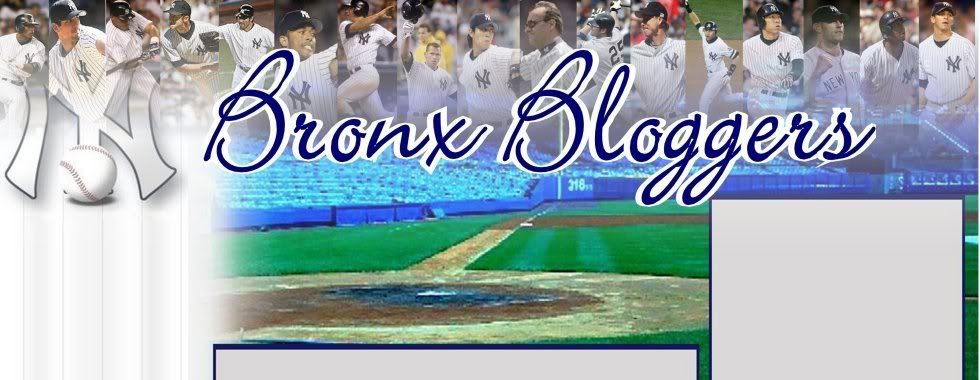
Wednesday, April 11, 2007
Scoring 101
It appears there have been no attempts on the contest below, so I will help yo out.
Introducing: How to Score Baseball by BronxBloggers (no college credits available, but it's free.)
First off, getting to the absolute basics.
1) Baseball is a nine-inning game with three out per half-inning for each team. The game can go extra innings to break a tie.
2) There are nine men on the field, a pitcher, catcher, first baseman, second baseman, third baseman, shortstop, left fielder, center fielder, and a right fielder.
3) Each one of those player have a turn at bat.
3a) Only in the American League is a designated hitter batting in place of the pitcher.
3a-1) The only exceptions are when the American League batter is playing a National League team in their ballpark. Interleague and the World Series are those exceptions.
4) Opposite the defending team, one batter is up at bat in an attempt to score runs.
5) Up to four offensive players are to be in play at a time, three on the bases, one at bat.
Basic enough for you?
Each defensive player is assigned to a number in which scorekeepers use to denote defensive plays:
1 - Pitcher
2 - Catcher
3 - First Baseman
4 - Second Baseman
5 - Third Baseman
6 - Shortstop
7 - Left Fielder
8 - Center Fielder
9 - Right Fielder
Common types of defensive plays include:
GO - Ground Out
FO - Fly Out
PO - Pop Out
Foul - Foul Out
FC - Fielder's Choice
DP(GIDP) - Double Play (Ground into Double Play)
E - Error
A - Assist
X - Tag Out
Immediately after these abbreviations, is the assigned defensive number to whom was credits for the play.
Scoring bases would be as follows:
First base - 1
Second base - 2
Third base - 3
Home - H
For example a double play was started by the shortstop, he tossed the ball to the second baseman who got an out, then threw to first for the second out. This play would be scored 643, or GIDP(643).
A more complicated play could be a DP4X2(3).
This means a double play was stated by the second baseman who tagged the runner on second base and threw the ball to the first baseman for the final out.
Let's break it up even more.
DP4X2(3)
DP - Double play, two outs. The 4X2(3) denotes how the play went.
4 - second baseman
X - out at leading base
2 -runner on second base
(3) - first baseman
Now fill in the blanks with common sense.
"A double occurred as the second baseman tagged out the runner advancing to third, then threw to the first baseman for the force out."
Still with me?
Let's get more complicated.
K/DP34x2[CS](3[CS])
In this scenario, the pitcher struck out the batter (K). The catcher (3) threw to second (4) to pick off the lead runner on second. The second baseman threw the first baseman for the out. The reason why the second baseman threw to the first baseman for the final out is because the catcher is credited for the out during a strike out.
K(2)
In this case, no put out was recorded, but instead a dropped third strike ensued and the runner was caught stealing first but was put out in the double play.
Ok, how many people have I lost so far?
The reason why the CS is in brackets, is to denote an out as part of the play.
Multiple numbers in a row [CS](3434143) almost always means a rundown play. In the provided sample, the play goes as follows:
[Caught stealing] (catcher - first baseman - catcher - first baseman - pitcher - first baseman - catcher).
With what I have taught you, we can now dissect the line of code for the contest.
FC5/DP.3XH(525);2XH(53436425)
Fielders choice started by the third baseman, double play started the runner on third was tagged out advancing home, (third baseman - catcher - third baseman); the runner on second was also tagged out advancing to home. (third baseman - first baseman - second baseman - shortstop - second baseman - catcher - third baseman)
The above play actually happened:
7-1-1927 CIN @ PIT: With one out in the top of the eighth inning, Cincinnati had Dolf Luque on third and Chuck Dressen on second. Billy Zitzmann tapped to Pie Traynor, and Luque was run down between third and home. Dressen was also run down between third and home after Pittsburgh tried to retire Zitzmann between bases: FC5/DP.3XH(525);2XH(53436425)
With that in mind, here is another line of code to decipher.
First correct answer wins 100 BE credits.
FC6/TP.3XH(625);2X3(54);BX2(4393)
-----------------------------------------------------------------------------------------------Labels: contest, scoring


 Posted by Steve Kenul at 6:47 PM
Posted by Steve Kenul at 6:47 PM



 « Home
« Home





